|
Home
Maine Coon
Males
Females
Kittens Information
Links
Contact
The Devon
Rex
Cherish
the old, cheer on the new!
Outcrossing the Devon
Rex, a necessity.
An
introduction for experienced Devon Rex breeders
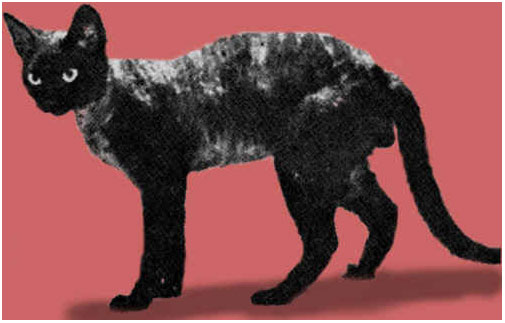
Kirlee
The
beginnings of the Devon Rex breed was a cat called Kirlee. But how did the breed
expand after his first litters? Yes indeed; via outcrossing!!
He
was unique, no second DRX around.
Have
a look at any DRX-pedigree on Pawpeds (click foundation) and you’ll find that
there are LOTS of breeds used for expanding of the DRX-breed; the Abyssinian,
American Shorthair, Asian , Balinese, British Shorthair, Burmese, Burmilla,
Cornish Rex, Exotic, Persian, Russian Blue, Siamese, Somali, Sphynx and the
regular housecat.(xsh).
This may explain why there so many different “types’ of Devon Rex; longer
heads, broader heads, higher-set ears, lower-set ears. Of course change of type
occurs within any breed, with or without outcrossing, depending on the choices
of breeders.
It definitely explains why some Devons carry the longhair gene and unfortunately
how some hereditary diseases (like PKD) snuck into the breed.
The biggest range of colours and tabby patterns can be found in the Devon Rex
because of outcrossing to different breeds: any tabby pattern, from ticked to
classic, Siamese,Tonkinese and Burmese points exist and an immense range of
colours: from solid black, via chocolate & cinnamon to apricot, golden, red,
cream to white. All with or without white and silver; anything goes as far as
coat colours is concerned. This is partly theory, because some coatcolours can
be difficult to determine in a DRX-coat and not all (like apricot, silver or
golden) are recognised as such.
All
cat eye colours can be found in Devon Rex as well.
Why
do we need to keep on outcrossing?
Good
question.
One could argue; so much outcrossing has been done already; there is no need, it
will only de-stabilize the type. True, that can happen, but what is really
frightening, gene-wise, is that in the average DRX-pedigree, 40% of the gene
material is Kirlee’s and inbreeding-coefficients are around 20/25 %, soaring
up to 45/50% when close linebreeding is done (father to daughter or brother to
sister) These latter practises are not rare and done usually to maintain type
and coat or unique colours, but most times to create the “perfect” DRX
specimen.
In itself these high inbreeding percentages and high percentage of similar
genematerial do not have to be a problem, but it will become a problem if
nothing new isn’t added to the gene pool. This development in breeding
practices will progressively weaken the individual cats and the breed therefore
in a heavy, irreversible way.
How
so?
A
process called inbreeding depression occurs.
To clarify thies, let
me quote an article on the Pawpeds-site, (Maine Coon Heritage site):
Inbreeding Depression:
Loss
of vigour due to the homozygosity of an increasing number of genes. The
inter-breeding of related cats, generation after generation, increases the
probability that the offspring inherits identical genes, over and over again.
This may result in an individual with a smaller variety of different genes in
its makeup. This in turn leads to the immune system becoming less effective.
Cats can only produce antibodies with the genes they have, the smaller the
number of different genes, the smaller the number of different antibodies
produced. The ability of an animal to generate antibodies is drastically reduced
if it loses its genetic diversity, in other words, comes from a small gene pool.
There may be greater proneness to illness, with longer recovery times. Kittens
may be smaller, lethargic, with poor growth, or stillborn. Reproductive
performance may be compromised.
In
short: all the things we don’t want for our cats!
What
to do for the gene pool?
I
would say, strike the golden mean and regularly introduce new, unrelated cats/
breeds into the Devon Rex population preferably avoiding those breeds which are
at present struggling so much with difficult health issues. Always cross
offspring back to well-typed Devon Rex though. All this will help refresh the
gene pool and increase vigour, without too big a risk of losing the type.
Remember though: to get healthy, sweet-tempered offspring, the parents have to
be richly endowed with these ingredients for starters.
Also very important factors to be considered, are coat and bodysize and
conformation. For example, Devons from outcross programmes often lose the
broadness of chest that Devons must have, and outcrossing to large breeds such
as NFC or Maine Coons would probably be undesirable because they are simply too
large and aside from not wanting such size in Devons, Devon queens could have
great difficulty with birthing larger kittens.
It
would be great if all DRX-breeder could do this with about 25% of their matings.
footnote
1
The
breed would benefit immensely and cats and humans alike would be so much
happier!
For
experienced breeders that have already worked this way, it could be feasible to
try and mate F1-offspring (smooth haired Devons) with curly, typefull F2’s. Or,
even more daring: mate two F1’s with each other and hope for curly, well-typed
offspring. If and when this is done, inbreeding can and will diminish a lot!
A
word of warning here! These latter practices are definitely not advisable for
new breeders. One has to be very familiar with the “feel” of the breed
standard and it would be a sad thing if one gets demotivated because of bad
outcomes. There is a bigger danger of that compared to F1 x DRX-matings.
How
do I go about it?
First
of all;
make inquiries with your cat club about their rules on outcrossing. Not all
clubs will allow it and rules on what breeds to outcross to, vary from country
to country.
In
the USA for instance, most clubs only allow the American Shorthair. In the
United Kingdom Burmese are used very often and housecats are not allowed. Fife (an
international club with affiliates all over Europe, South- America and
South-East Asia) will allow any well-argumented proposal. Change clubs if yours
won’t allow you to outcross.
Then
get in touch with
experienced outcross-breeders that can advise you. Co-operation, in trust, is
the keystone to successful breeding no matter what; we cannot make a substantial
contribution to a breed on our own!
Sure,
for the type-outcome of outcross matings there is less predictability than for
DRX x DRX-matings, but the reward and thrill of seeing curly babies being born
and grow up ánd be admitted officially to the breed is not to be missed.
Do try and think ahead on how you will find new homes for smooth haired kittens.
No, you can usually not ask the same price for them as for curly kittens, but
making a good new owner-kitten-match is nice with any kitten and the smoothhairs
often have the same charm and wit as the curly kittens and make great pets. You
can see if your buyers will take a straight coated with their curly kitten for a
companion.
Work
a lot on cooperating
with trusted co-breeders. Two or three know more then one and practical and
“mental” advice and support is like the air we breath: without it we
suffocate and die an early death. No one can support a innovating
breedingprogramme and make it work in a substantial way on their own! But if you
cannot find anyone to support your plans right away, do get started on your own.
Good work and advice will always create more good work.
Choices
As
in “regular” breeding there are always many choices to be made.
Here are some important subjects:
1.
health,
2.
temperament,
3.
type, consisting of headtype, bodytype and last but not least:
coatstructure
4.
good fertility and motherhood
5.
blood groups,
6.
colouring of the parents.
These
“ingredients” can make or break a new litter.
I would suggest: choose a combination of parents bearing the importance of the
ingredients in mind, in the order given here.
1.We
all know every breed can have it’s health problems,
the DRX is no exception. (Myopathy, Patellar Luxation f.i.) Make sure your DRX
is nice and healthy. I personally have my breedingcats tested for Patellar
Luxation, HCM & PKD (the latter 2 via ultrasound) as these diseases have
been found in the breed and are hereditary. My club always requires a negative
Felv/Fiv test.
A
word of warning:
the DNA-test for PKD does not necessarily detect this in Devon Rex. More
info on testing for these diseases can be found on the Pawpeds-site,
healthprogrammes. To prevent Myopathy in my kittens, I try and get as much info
as possible on the occurrence of this disease in the pedigree of their parents,
by making inquiries with breeders.
Why
add more health problems to the breed when choosing f.i. an Abyssinian parent
that has not been tested for Pkdef? Or a Brit that has not been tested for PKD?
Please
do all your homework by making extensive inquiries with clubs and breeders
before proposing a combination. Visit the cat and his/her owners.
2.
choose a sweet-tempered, inquisitive set of partners.
3.
of course it’s important
to always use breeding animals that have proven themselves in this matter or
come from lines that are reliable.
4.
always make the choice of the DRX-parent a well-typed one,
so get to know the Devon type well! Go to shows and talk to judges, visit
experienced breeders and compare notes and details with them. A good DRX-type
gives us the biggest chance of the type not being snowed under by the type of
the other breed. The same goes when mating a regular DRX to an F1 or F2 DRX. For
further breeding, always use the most typefull offspring!
Get
to know the DRX-type very well!!
The preferred non-Devon
partner
Bodytype
The
size should of course come near that of a DRX, so a Bengal or a Norwegian
Forestcat is obviousely not a good choice. Breeds that have succesfully been
interbred with the DRX are:
the
housecat.
Although very often not much of it’s ancestor’s healthhistory is known,
their type is “malleable”, has a less fixed type.
“But’s” are: it has to be one that does not live outdoors (think of Felv/Fiv-testing,
allow an incubationtime of 2 months!!!), have a reliable, sweet temperament and
it shouldn’t be too big. (a boy may of course be bigger than the girl, both
ways around)
A European Shorthair is good alternative if there are some available in your
country
Furthermore
the European Shorthair (Scandinavian Countries are well stocked), Burmese,
Asian (in the UK), Abyssinian & Somali, American
Shorthair (if used exclusively, like is done in the USA, the offspring may
start looking too much like the AS), British Shorthair, Exotic (Persian)
and the “old” Siamese. They all have the obvious
bodytraits-disadvantages that clash with the DRX: too stocky, too slender, too
square, tails too short or long and so on.
All
these different breed can provide a possibility to balance out
bodyparts from your Devon Rex that are lacking. If for instance the
DRX-parent’s muscles could benefit from some “oomph”, maybe try a Burmese
or Asian.
A
big no-no is:
Sphynx (or other bald cats). Because the
genepool of this breed was broadened with Devon Rex, both Devon Rex and Sphynx
may carry some of the other breeds genes, causing hairy Sphynx and bald Devon
Rex, not really helpful therefore.
The
recessive re-gene responsible for the wavy coat, is yet more recessive to the
gene responsible for the baldness in the Spynx. So when Devons were used to
outcross with the Sphynx, naked Sphynx-babies were born. Not a happy marriage.
Headtype
The
preferred headshape is triangular, a nosedip is present (not straight or Roman),
flat skull, ears preferably not high-set and as big as possible. Again a good
starting point is to find out if your DRX-parent’s head may need improving: if
the muzzle could be shorter; a Brit may help, is the face too narrow: an Exotic
may help or vice versa.
Be
careful with pointy muzzles and rounded skulls in the outcross-breeds. They are
hard to correct in offpring.
Coat
Obviousely
a shorthair always is first choice.Some
DRX are longhairgene-carriers and longhair kittens are born regularly, if not
too often. (Fortunately this does not have to bother kittenbuyers, not at all,
the longhairs often have special fans.) The breedstandard does not allow
longhairs though.
If
you feel however that a Persian or Somali would make a good match for your Devon
Rex, there is always the choice of having their kittens tested for the
longhairgene to help decide on choosing a breedinganimal from that litter.
Ideally your outcrossbreed has as little guardhairs as possible
5.
do their blood groups add up? Any
DRX-breeder has to know how to work with the different bloodgroups. About
45/50% of the DRX already has bloodtype b, so if you don’t know about it,
learn it first! (see extra info below)
6
if your challenge is to get new colours or more outspoken patterns into
the DRX-breed: please go ahead, but try not to forget about all the other
important factors mentioned above. Whatever the outcome of your colouringwork
may be: please be comforted by the thought that there are lovers for any colour
and you may be contented with your effort for uplifting the breed in many more
important ways.
Criteria for choices in offspring
remember
to be very critical on this subject! If outcrossing Devon Rex only
provides a decline in type on a constant basis, many DRX-breeders will get
demotivated and loose interest. Not what we want.
How
do I know which kitten to pick for breedingpurposes?
First
of all, make notes at birth, specifically about headshape, muzzleshape &
presence of dip.Then, do not make a definite choice before the age of 8 or 9
weeks!! The type will then have set a little.
Make a shedule of all the pros and cons of your offspring (either F1 or F2)
using yet again all the choice-subject mentioned above for as much as you can of
course.
In
F1’s try to look
beyond the smooth hairs for headtype, eyes and eyeset, earset &-size,
muzzleshape and length, skullshape (rounded or flat) and bodystructure and size
(not too stocky?) But, do not be too picky. Look ahead and imagine a good
DRX-partner to make improvements.
F2’s
are more prone to
have a better type, but this is not a rule!
Basically,
F2’s should be real Devon Rex that meet the breedstandard, with maybe 1
or 2 parts less well developed (f.i. the tail is a bit too short or the ears are
too highset). The coat should also be a normal Devon Rex coat, but never hold
your breath.
If
you are not happy with the type of your offspring, do not
sell them to other breeders. Maybe
keep one yourself and try and improve the type by using partners that balance
out the minuses in your offspring. Always try and find co-breeders that you
trust and talk, talk, talk things through.
Sometimes we have to take our losses though and a well planned litter cannot be
used for breedingpurposes.
Registrating
F2’s and other club-rules
I
can only tell you about my clubrules Felikat, a Fife-member.All kittens of
approved matings will get a certificate of origin. It looks exactly like a
normal pedigree. The cat is registered in the Riex. (addition to the official
pedigree database)
For
F1’s goes:
permission for breeding is required.
F2’s
can be officially admitted to the breed. After permission from the registrar, an F2 (at least 3
months old) can be judged on a show by two separate judges
for breed-likeness (controlclass). The signed report can be send to the
registrar, together with the certificate of origin and your kitten will be
baptized: Devon Rex and you’ll get another certificate of origin denominating
your kitten Devon Rex and not XSH (unknown/unregistered shorthair)
These
F2’s will be written up into the regular pedigree database and can be used for
breedingpurposes without having to ask special permission.
Make inquiries with your own registrar on their
rules. In general the modus operandi will be similar.
Photo-examples
of
some cats in my outcross-programme
Photo pedigree of
Boonland's Samoen 2017
Pawpeds
Pedigree:
click

Boonland's Hermes |
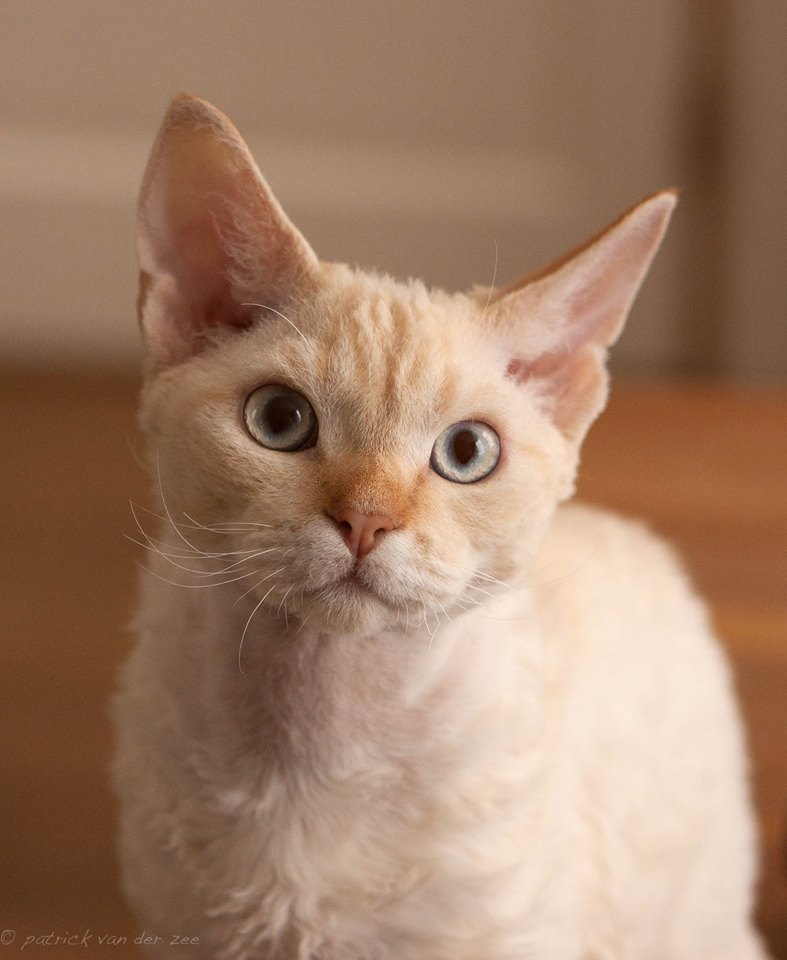
Rextopia's Taste of Cinnamon
(f2) |
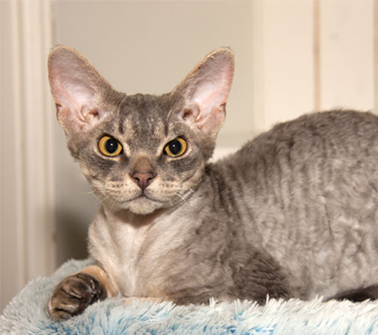
Boonland's Haki (f2 |

Rextopia's Lionel Richie |
med.jpg)
Dingbats Cinnamon Spice (f1) |
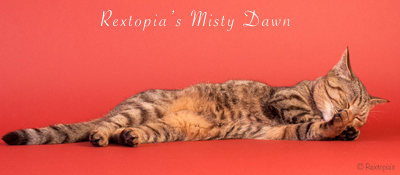
Rextopia's Misty Dawn (f1) |
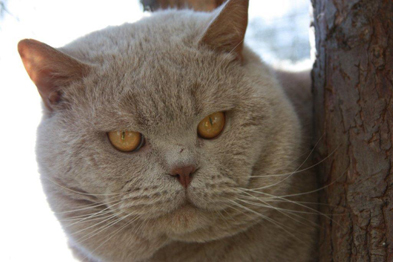
Sham Cuba Masculino (BRI) |
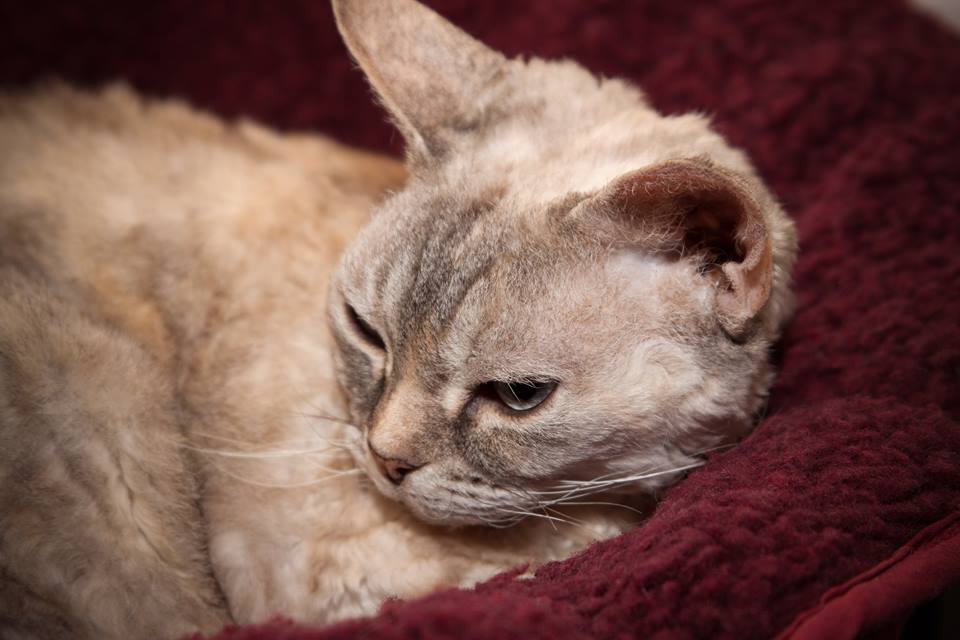
Grizabella Donnatella |
.JPG)
Boonland's Kiss |

Cloudborn Crowdie 'n Cream |

Cloudborn Loves to Boogie |
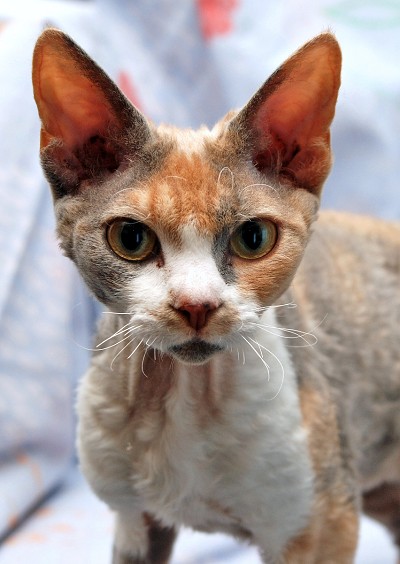
Cherek Vera Puzzled |
med.jpg)
Boonland's Ginger Rogers |
.jpg)
Smoothasilk Brandyboy |
med.jpg)
Karlijntje van Sophal's Choice |
|
medcr1.jpg)
Boonland's Xiri (f1)
|
 Boonland's Haki (f2) |

Rextopia's Lionel Richie |
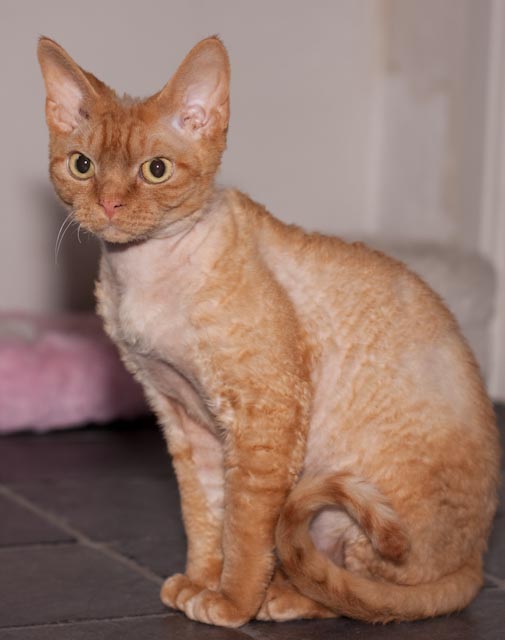
Saskakhan's Maurice |
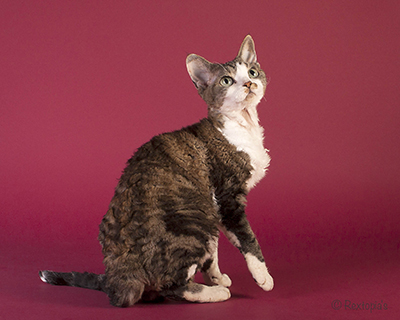
Rextopia's Ebony |
med.jpg)
Dingbats Cinnamon Spice (f1) |
Shan Ling O Cinnamon (Som) |
|
Makinwaves de Angel DRX |
crmed.jpg)
Saartje, huiskat |
??? |
|
med.jpg)
Nicky |
Extra info
For
more information on DRX-outcrossing,
-
I
always find the following shedule very enlightening to weigh out the pros
and cons of inbreeding and outcrossing. In this shedule outcrossing
is considered using unrelated individuals within 1 breed. The outcome
of outcrossing to another breed (hybridisation in this schedule)
is of course even more gene-rejuvenating!
PROS AND CONS OF INBREEDING
Copyright 1996, 2001, 2003 Sarah Hartwell
|
|
PROS
|
CONS
|
INBREEDING
(Mating
of closely related individuals)
|
Produces
uniform or predictable offspring.
Hidden (recessive) genes show up and can be eliminated.
Individuals will "breed true" and are "pure."
Doubles up good genes.
Eliminates unwanted traits.
|
Doubles
up on faults and weaknesses.
Progressive loss of vigor and immune response.
Increased reproductive failures, fewer offspring.
Emphasis on appearance means accidental loss of "good" genes
for other attributes.
Genetically impoverished individuals.
|
LINE-BREEDING
(Mating
of less closely related individuals)
|
Avoid
inbreeding of very closely-related cats, but cats are still
"pure".
Produces uniform or predictable offspring.
Slows genetic impoverishment.
|
Require
excellent individuals.
Does not halt genetic impoverishment, only slows it down.
|
|
OUTCROSSING
(Mating
of unrelated individuals within the same breed)
|
Brings
in new qualities or reintroduces lost qualities.
Increases vigour.
Cats are still "pure".
|
Less
consistency and predictability of offspring.
May have to breed out unwanted genes accidentally introduced at same
time.
May be hard to find individuals which are true outcrosses.
Note:
within 1 breed
|
|
HYBRIDIZATION
(Mating
of unrelated individuals of different breeds)
|
Brings
in new qualities or reintroduces lost qualities.
Increases vigour, may improve immune system and reproductive capacity.
Introduces totally new traits e.g. colour. Fur type.
May result in new breeds.
The offspring are considered "impure" for many generations.
|
Unpredictable
- new traits may not all be desirable.
Must choose outcross breed whose qualities complement or match own
breed.
May take years to eliminate unwanted traits/loss of type.
May take years to get consistent offspring.
Produces many variants not suitable for use in breeding program
|
footnote
1:
This may be necessary in some countries, e.g. in
Europe where distances are shorter and it probably has been relatively easier
for breeders to continually breed Devon-to-Devon for many generations. However,
in some parts of the world, the inbreeding coefficient is much lower generally
than we may be looking at in Europe. If yours is around 40% and more, and
because of the relatively tiny genepools (e.g. NZ) outcrossing has been a
regular feature of serious breeders’ programs since the very first imports
from England in the 1970s.
source: Pam Dowling,
Cattery Madcap Devon Rex/outcrossbreeder since 1978.
One
last word:
I
do not claim to have all the knowledge necessary to be a successful outcross-breeder. Driven by the need to help our charming, special breed become
more resilient and vital, I started my own outcross-programme and along the way
tried to get as much information as possible from experienced, wise Devon Rex (outcross)-breeders.
This
informationsheet is an attempt to bundle up their and my joint knowledge.
Go
ahead, take the plunge and good luck to you all!
Marjan Boonen
“No
man is an Island “: John Donne (1572-1631)
Many
thanks to all those co-breeders for trusting & helping me.
Special
thanks to Pam Dowling of Madcap Cattery, New Zealand
|
crmed.jpg)
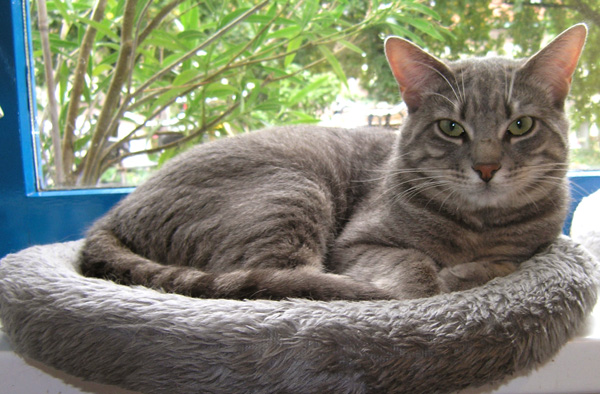
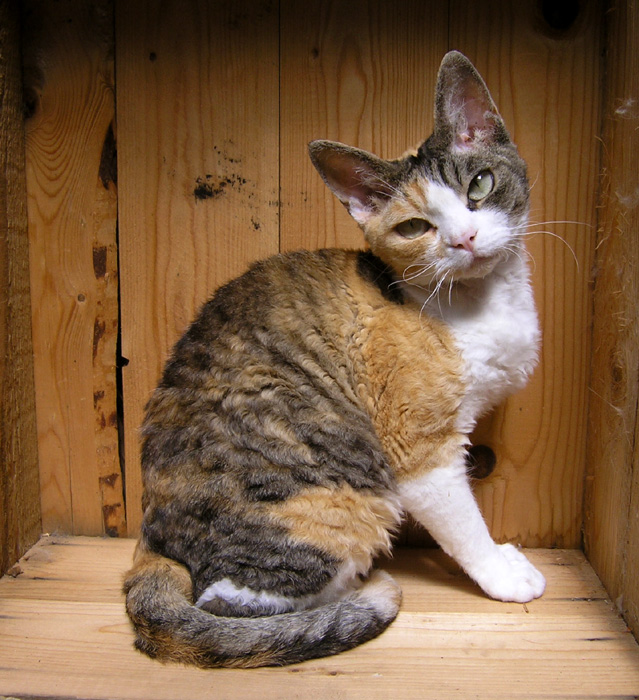
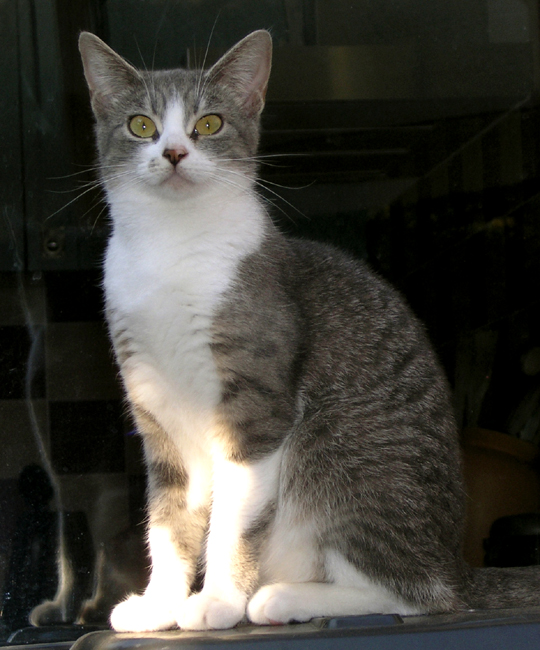
mini.jpg)

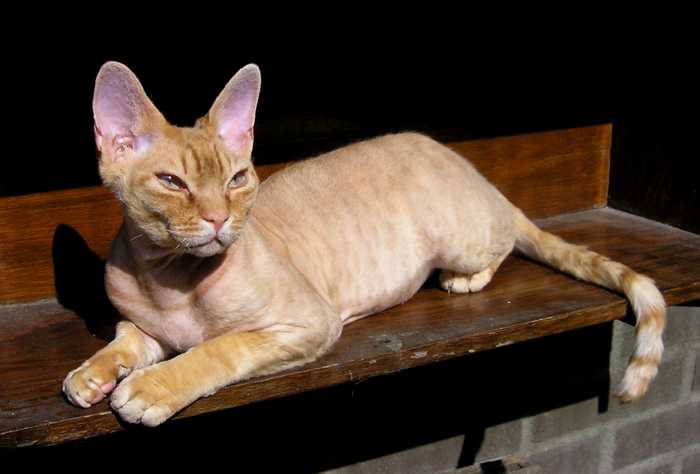
mini.jpg)




med.jpg)






med.jpg)
.jpg)
med.jpg)



med.jpg)
crmed.jpg)
med.jpg)

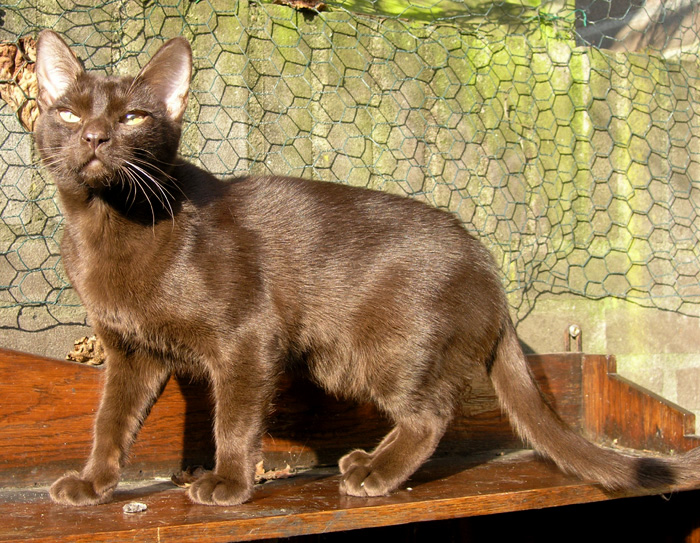
medcr1.jpg)